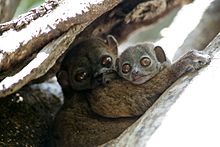| Hawks' sportive lemur | |
|---|---|

| |
| in Lokobe Strict Reserve | |
| Conservation status | |
 Critically Endangered (IUCN 3.1) | |
| CITES Appendix I (CITES) | |
| Scientific classification | |
| Domain: | Eukaryota |
| Kingdom: | Animalia |
| Phylum: | Chordata |
| Class: | Mammalia |
| Order: | Primates |
| Suborder: | Strepsirrhini |
| Family: | Lepilemuridae |
| Genus: | Lepilemur |
| Species: | L. tymerlachsoni |
| Binomial name | |
| Lepilemur tymerlachsoni Louis et al., 2006 | |

| |
| Distribution for L. tymerlachsoni | |
Hawks' sportive lemur (Lepilemur tymerlachsoni), also known as the Nosy Be sportive lemur or Nosy Be weasel lemur, is a sportive lemur endemic to Madagascar. Like all members of its genus, it is solitary, nocturnal and largely folivorous. It is threatened by habitat loss and unsustainable hunting.
Taxonomy and phylogenetics
Hawks' sportive lemur was described in 2006 based on genetic samples and morphometrics collected in 2003 and 2004. The specific epithet tymerlachsoni honors the Howard and Rhonda Hawk family.
The name was corrected to L. tymerlachsonorum in 2009 under the incorrect assumption that the name was based on a husband and wife team. The original form is therefore considered the correct version.
Genetic analyses show Hawks' sportive lemur to be an outgroup to a clade containing the Ankarana sportive lemur and the Daraina sportive lemur.
Description

Hawks' sportive lemur is light brownish-gray with the upper half of the back a lighter reddish-brown. The underside is a light grayish-white. The outer side of the thighs and edges of the extremities also have a light reddish-brown color. A dark brown to black stripe is present from the head to the lower half of the back. The face is gray. The tail is a uniform light reddish-gray to brown.
It is a moderately large sportive lemur, with a total length of about 50 to 68 cm (20 to 27 in), of which 22 to 27 cm (8.7 to 10.6 in) is the tail.
Distribution and habitat
Hawks' sportive lemur is endemic to Nosy Be island, Madagascar, where it is only known from Lokobe National Park and adjacent degraded forest. It is estimated to occupy an area of less than 72 km and occurs from 12-35 metres above sea level. Within Lokobe National Park, it has been recorded to achieve an average density of 63.2 individuals/km.
The main forest type within its range is lowland rain forest, although the region experiences a distinct dry season.
Selection of daytime sleeping spots change according to habitat type, with individuals favoring tree holes in dense primary forest and dense vegetation tangles in more open deciduous forest.
Threats and conservation
Hawks' sportive lemur is threatened by forest degradation and clearing for agriculture and timber resource extraction. Additionally, it is locally hunted at an unsustainable rate, and captured individuals have been recorded being sold to tourists. To combat loss of suitable habitat, nest boxes have been placed in degraded forest areas.
References
- ^ Louis, E.E.; Bailey, C.A.; Raharivololona, B.; Schwitzer, C.; Wilmet, L.; Roos, C. (2020). "Lepilemur tymerlachsoni". IUCN Red List of Threatened Species. 2020: e.T136709A115585199. doi:10.2305/IUCN.UK.2020-2.RLTS.T136709A115585199.en.
- "Checklist of CITES Species". CITES. UNEP-WCMC. Retrieved 18 March 2015.
- ^ Louis Jr., E.E.; Engberg, S.E.; Lei, R.; Geng, H.; Sommer, J.A.; Ramaromilanto, R.; Randriamanana, J.C.; Zaonarivelo, J.R.; Andriantompohavana, R.; Randria, G.; Prosper; Ramaromilanto, B.; Rakotoarisoa, G.; Rooney, A.; Brenneman, R.A. (2006). "Molecular and morphological analyses of the sportive lemurs (Family Megaladapidae: Genus Lepilemur) reveals 11 previously unrecognized species" (PDF). Texas Tech University Special Publications (49): 1–49.
- Hoffman, M.; Grubb, P.; Groves, C.P.; Hutterer, R.; Van der Straeten, E.; Simmons, N.; Bergmans, W. (2009). "A synthesis of African and western Indian Ocean Island mammal taxa (Class: Mammalia) described between 1988 and 2008: an update to Allen (1939) and Ansell (1989)" (PDF). Zootaxa. 2205: 1–36. doi:10.11646/zootaxa.2205.1.1.
- Lei, Runhua; Frasier, Cynthia L.; Hawkins, Melissa T. R.; Engberg, Shannon E.; Bailey, Carolyn A.; Johnson, Steig E.; McLain, Adam T.; Groves, Colin P.; Perry, George H.; Nash, Stephen D.; Mittermeier, Russell A.; Louis, Edward E. (3 October 2016). "Phylogenomic Reconstruction of Sportive Lemurs (genus Lepilemur ) Recovered from Mitogenomes with Inferences for Madagascar Biogeography". Journal of Heredity. 108 (2): 107–119. doi:10.1093/jhered/esw072. ISSN 0022-1503. PMID 28173059.
- Garbutt, Nick (2007). Mammals of Madagascar, A Complete Guide. Yale University Press. pp. 126–127. ISBN 978-0-300-12550-4.
- Tinsman, Jen; Volampeno, Sylviane; Ganas-Swaray, Jessica; Gann, Daniel; Andrianirina, Natacha; Chamizo, Madison; Ralazampirenena, Claude; Ranaivoarisoa, Jean F.; Ravaoarisoa, Hasina; Rivero, Josie; Zamora, Andrew; Gomes, Cristina M. (2022). "Habitat use by the island lemurs of Nosy Be, Madagascar". American Journal of Primatology. 84 (3): e23362. doi:10.1002/ajp.23362. ISSN 0275-2565. PMID 35098568.
- Bederu, Millan (2014). "Preliminary data on population density and habitat use of Lepilemur tymerlachsonorum in Lokobe National Park". Lemurs News. 18: 2–4.
- Sawyer, Rachel M.; Mena, Honaisiford Edwin; Donati, Giuseppe (1 January 2015). "Habitat use, diet and sleeping site selection of Lepilemur tymerlachsoni in a disturbed forest of Nosy Be: Preliminary observations. | Lemur News | EBSCOhost". openurl.ebsco.com. Retrieved 12 July 2024.
| Taxon identifiers | |
|---|---|
| Lepilemur tymerlachsoni | |